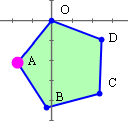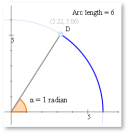IntMath Newsletter: radians, graphs, math class
By Murray Bourne, 01 Jun 2010
1 Jun 2010
In this Newsletter:
1. Math tip: Radians
2. JSXGraph - Interactive javascript graphs
3. Video: Math class needs a makeover
4. IntMath Poll result - best time to study math?
5. Final thought – Contemplating nature
1. Math tip: Radians
Suitable for: You will all come across radians at some stage. Even if you have seen them before, you can still learn something.
|
Radians are an important alternative way of measuring angles. Radians are more common than degrees in science and engineering applications. This article has an interactive graph where you can investigate what a radian actually means. Find out more in: |
2. JSXGraph
Suitable for: Students (you can learn while exploring the graph examples), and instructors (you can see how easy it is to start creating your own interactive graphs for your classes).
 |
JSXGraph is a method for producing interactive graphs on a Web page, using javascript. There are several advantages over Flash-based graphs. It's great for those who need to see before they understand. Find out more in: |
3. Friday math movie - Math class needs a makeover
 |
When students understand math is a tool for solving problems, and start using the tool in that way, it is less likely to be boring. This video suggests some ways to make that possible. Do you agree with him? |
4. IntMath Poll result - what's the best time to study math?
The poll in May 2010 asked readers about their math study preferences. Should we consider a ban on afternoon math classes as a result?
The question and responses were:
What time of the day do you find most effective for math study?
Morning (6AM to noon)
36%
Evening (6PM to 10PM)
24%
Night (10PM to 1AM)
21%
Afternoon (noon to 6PM)
19%
Total votes: 2000
A new poll is up and asks readers what they are looking forward to doing during summer.
You can respond on any page in IntMath.com.
5. Final thought – Contemplating nature
The following thought comes from the famous Greek mathematician Pythagoras. His secretive mathematical-religious community didn't speak to each other much and spent most of their time thinking about numbers and solving problems.
They investigated primes, perfect numbers, amicable numbers, the ratios involved in musical pitch and of course, lenghts of sides of right-angled triangles.
In life, some enter the services of fame and others of money, but the best choice is that of these few who spend their time in the contemplation of nature, and as lovers of wisdom.
Pythagoras (580-520 BC)
Until next time, enjoy whatever you learn.
You can subscribe to the fortnightly IntMath Newsletter on any page in Interactive Mathematics.
See the 6 Comments below.

2 Jun 2010 at 3:43 am [Comment permalink]
Thank you for this informative math article.inthmath site is the best site to learn mahematics.Keep up it in future.Thank you once again for this informative article.
3 Jun 2010 at 7:19 am [Comment permalink]
thanks for sharing the TED video of Dan Meyer speaking about how to engage students in math. Wow. I instinctively knew that, but did not know how to present it so enticingly!
Love your e-newsletter. Keep sending, it's mentally stimulating and I think about the topics for days after reading.
3 Jun 2010 at 8:51 am [Comment permalink]
Thanks for the positive feedback, Dilli and Jackie.
I'm glad you found the IntMath Newsletter useful!
3 Jun 2010 at 4:36 pm [Comment permalink]
Murray ,thanks for the powerful quotation from Pythagoras, "Contemplating nature". I have displayed this in my Maths lab and my students like it.
3 Jun 2010 at 7:41 pm [Comment permalink]
You're welcome, Desmond!
8 Jun 2010 at 5:47 am [Comment permalink]
Great to get your latest.... keep up the good work!